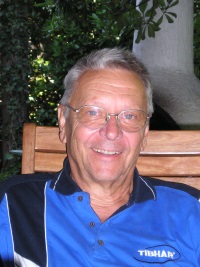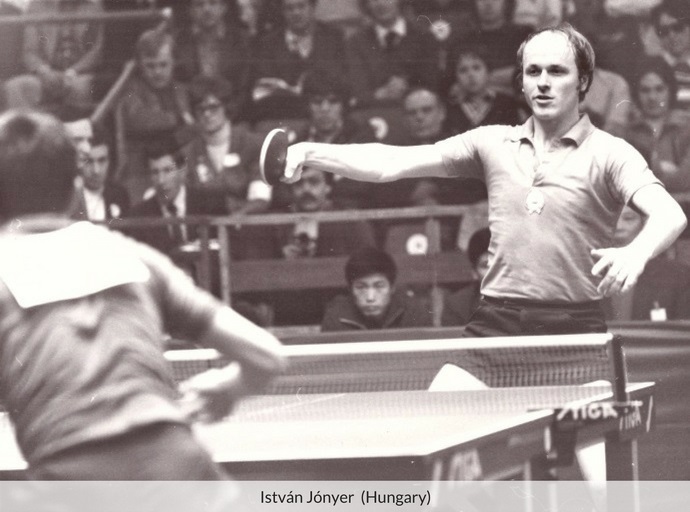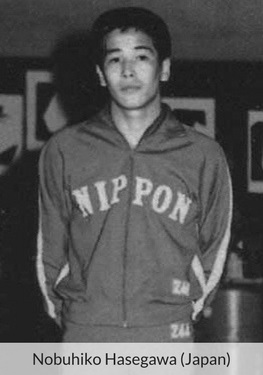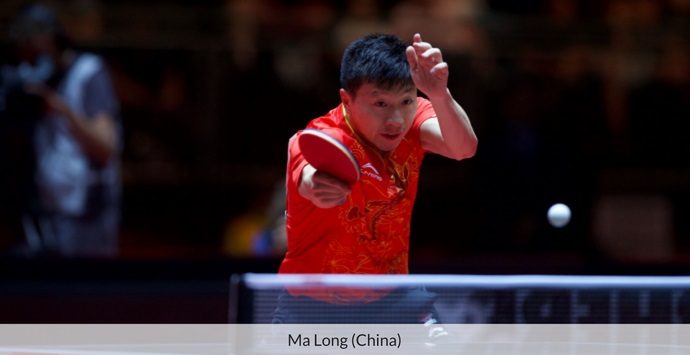A History Lesson: How Topspin Revolutionized Table Tennis
17 October 2017 | Posted in: Fun & Inspiration
About the author

Radivoj Hudetz is a 70-year veteran of table tennis and the Chairman of the ETTHoF board.
He's the coach of Bayern, the German junior team, the Yugoslavian national women team, and the Yugoslavian champion women team HASTK Mladost Zagreb. He's an author of several books on table tennis techniques, tactics and history. He's also the chief editor of table tennis periodicals “Tischtennis aktuell” and “SPIN”, and an author of several films and DVD’s on table tennis. He's also the former president of Yugoslav Table Tennis Association and the former General secretary of Croatian TT Association. He was the tournament director of World Championships 2007.
Currently he's a honorary member of ETTU and a member of ITTF President Advisory Council. He's been honored with ITTF award of merit, with the Croatian Table Tennis Association’s Trophy and with the Sport Award of Croatian Republic.
How Topspin Revolutionized Table Tennis
It's the 1950s. Fashion is changing, music is changing, and political ideologies are changing. Though not only that, the world of table tennis has begun to change too. At the beginning of the decade, short pips were the name of the game and everyone was using classic hardbat rackets with short pips and no sponge.
The first player to use a sponged racket instead of hardbat was an Austrian player named Waldemar Fritsch. During the team event of the World Championships in 1951, this underdog surprised the whole crowd and was able to defeat several of the top world class players. Using his racket covered with black sponge, Fritsch made a statement to the world that sponged rackets would be the future of table tennis.
We've now reached 1952. For the first time ever, Japan is participating in the World Championships. Japan's 3rd player Hiroji Satoh makes a splash! Like Fritsch before him, Satoh enters the competition using sponge on his racket and is able to win the men's singles event.
The following year in 1953, Japan didn't enter the World Championships. As a result, Ferenc Sido of Hungary became the men's singles champion for that year. He became the last world champion to win using a hardbat racket.
It's 1954 and Japan, seeking to reclaim their title, enters the World Championships in London! Ichiro Ogimura (using sponge of course) takes the title. However, the events preceding the tournament were quite unusual for the Japanese team. The Japanese Table Tennis Association (J.T.T.A) were quite low on funds that year and were unable to send any representatives over to the tournament. So, Ogimura started to collect money from private donors to pay for his trip to London. After arriving in London, Ogimura decided during his first training session that his super thick 1cm (yes 1 centimeter!) sponge was too much and cut it down to 4mm.

In the coming years, almost all top class players used rackets covered with sponge. With more players using sponged rackets, table tennis grew into a chaotic state. You see, a ball hit by a sponged racket is much faster and more powerful than what players had previously been used to. This often resulted in rallies being finished and decided by only a single shot.
In 1955, during the men's finals in Utrecht, Tanaka of Japan and Dolinar of Yugoslavia faced each other using sponged rackets. This resulted in the shortest final in table tennis history. Tanaka won 3:0 in a mere 17 minutes! Rallies were lasting only one or two shots. Talk about a quick decider!

In 1959, the International Table Tennis Federation (I.T.T.F) decided to ban bare sponge as a racket covering. Sponge itself was not completely banned, a so called “sandwich” rubber was permitted. This meant having sponge as a base which is then covered by a sheet of pips out rubber. Though quite soon after, inverted pips in rubber was created. The grippy surface of inverted rubber opened the door for the development of a new attacking stroke with extreme forward rotation... that's right, you guessed it, the topspin loop!
Almost immediately, players playing with this new “reverse” rubber started to make use of the possibilities given by the new equipment to produce augmented rotation speeds using the grippy surface of this new rubber type.
Hungarian players like Bubonyi started to play a high “balloon” defense using lobs and fishes with strong spin instead of the traditional chopping defense. Players like Fahazi and Rozsas soon produced such strokes as to allow players to remain more offensive in more situations that previously required defense. These were the first steps toward what we today know as topspin attack.
Top Japanese players had a lot of trouble playing against European chopping specialists such as Zoltan Berczik of Hungary and Vilim Harangozo of Yugoslavia among others. So, in 1960 Japan developed a more modern topspin loop with heavy rotation in response.
With their newly developed techniques, later that year in the summer, Japan invited the top 4 European choppers (Berczik, V. Harangozo, Sido, Vogrinc). They were invited to participate in some matches to put their new topspin attack to the test. The proceeding events turned out to be a series of devastating defeats for Europe. These once star choppers were playing against truly heavy topspin for the first time and had no idea how to put the ball back on the table.
A New Era in Table Tennis Had Begun!
I was one of the training partners of Vogrinc at the time. He wasn't able to win a match with his attack against my defense, and I was also not able to win with my attack against his defense. This meant that our matches in tournaments and in training were always full of very long rallies.
Once Vogrinc returned from Japan we met for our first training session and he told me that he would beat me in no time with his new attack that he learned in the east. I thought he was joking but it actually happened. Before I knew it, it was 3-0 and I had lost! After being in Japan for only a single month, Vogrinc acquired this new forehand stroke and evolved as a player.
Today, even junior players can produce a much better topspin, but at the time such a topspin was enough to finish the point after the first topspin stroke. In the beginning, nobody knew how to hit back a ball with such strong spin, myself included!
Later in the Autumn of 1960, once all of the aforementioned top choppers of Europe had returned from Japan, many players started to utilize this new topspin stroke in Europe. In the beginning, players who were able to master heavy topspin strokes became new stars instantly. Karkar, an Indian student in Germany, who was only a mid-level player, mastered heavy topspin and in no time became almost unbeatable. In Yugoslavia, Biscan, a young no name player became a new champion among several world class players simply because he was able to play two or three consecutive balls with heavy topspin.
Chinese penhold attackers such as Zhuang Zedong, Li Furong, Hsu Yinsheng and their contemporaries dominated the first half of the 1960s, playing a fast attack hitting style with short pip sandwich rubbers. Topspin attackers like Surbek and Stipancic (Yugoslavia), Jonyer and Klampar (Hungary), Johansson and Bengtsson (Sweden), and Hasegawa (Japan) started their domination at the middle of the decade.

Topspin as an attacking stroke (the topspin loop) became possible with technological advancements in equipment. With pips-out rubber, such a stroke was simply not possible. In the beginning, looping was performed only against chopping defense as it was designed as a weapon against the heavy underspin that chopping can create. Players during this era did not know how to handle balls with such strong topspin so the initial response was to try to prevent the opponent from looping with their own attack. Fighting fire with fire. So even the best European defender and champion at the time, Berczik, totally gave up chopping and started to play as an offensive player in order to prevent the opponent from using loops with heavy spin!
Offensive players soon answered this by starting to loop against attacks given by the opponent. Thus, loop and counterloop duels became a part of the table tennis game.
New Rubbers Enter the Scene
Parallel with the development of new topspin techniques against topspin, new rubbers to handle topspin were developed too. In the mid sixties, antispin rubber and in the mid seventies, long pips rubber appeared.Initially, the loop was played as only a forehand stroke. Arndt, a player from Germany, was the first one to utilize the backhand loop attack. In 1962 he became the European vice-champion as the first top player who used both wings to topspin attack! The birth of the two wing looper. For quite some time, backhand looping was considered a very unique technique that was reserved only for a few players. Only later on did players like Jonyer and Stipancic introduce backhand looping into the mainstream, though at first only for European shakehand players.
It took a while for Chinese penhold players to begin using the backhand loop and it became a big problem for them to initiate attack from the backhand side. They found a solution much later, they started to play backhand loops with the penhold grip by turning the racket and playing backhands with the reverse side of the racket (reverse penhold backhand). Prior to this new technique they used only one side of the racket for both forehand and backhand strokes. By the end of the 90s a young Wang Hao would begin mastering the technique, becoming the most well known user of this technique as of the time of this writing (but probably of all time). Today, most Chinese penhold style players use reverse penhold backhand and players with Japanese penhold grip usually can't because of the different style grip, handle, and racket head.
In 1968, a new generation looping attacker, Dragutin Surbek, from Yugoslavia became European champion. He was playing with Butterfly D13 rubber, a rubber that would not even meet the demands of an average junior player today. By the end of that year, the first new generation rubber Butterfly Sriver appeared. Yasaka Mark V appeared the following year. These rubbers enabled players to perform topspin with a lot more rotation and speed. It was quite a change for the game; the life of defenders became very tough.
The change between old and new generation rubbers at the end of the sixties is comparable with the change that happened in the mid eighties when Klampar of Hungary and Surbek of Croatia invented the so called “speedgluing” which made it, once again, possible to create topspin with more rotation and speed.
Klampar used to change his rubbers, just like Surbek, quite often. Both noticed that after they glued a new sheet of rubber to the wood, the racket immediately became faster, it was possible to produce more spin, and the sound of the racket changed. So both players started to deliberately change their rubbers before the match. Afterwards, they did not change the rubber each time but only glued the old rubber fresh to the wood. Other players noticed what Klampar and Surbek were doing and so “speedgluing” was born.
The World Championships in 1961, 1963 and 1965 were dominated by the Chinese. They played all three finals in men's singles for those three consecutive tournaments. Not only that but it was Zhuang Zedong against Li Furong every time, with the same winner Zhuang Zedong... every time!
From 1965 up to 1971, Mao Zedong was putting his “Cultural revolution” into action so China did not participate in any international sport activities during that time period. Europe and Japan struggled for leading positions in table tennis in the second half of the sixties.

During the World Championships of 1967 in Stockholm of an all Japan men's singles final; Hasegawa emerged as the new champion. He played with an unusual version of the shake hand grip and was a typical Asian type of spin attacker. While European spin attackers played relatively slow balls with extremely high spin, Asian players like Hasegawa played faster balls with less spin.
At the World Championships 1969 in Munich, again lacking China, penhold spin attacker, Itoh from Japan, won the final game against Schoeler of Germany. Schoeler is considered to be one of the best defenders of all time. Schoeler was leading in the final game 2-0 but then Ito started to play better and better and was able to pull out the victory winning 3-2. After winning the match, for the first time in table tennis history, there were rumors that Itoh was doping but these were only rumors and nothing official confirmed anything one way or the other.
Topspin Looping Style Becomes the Standard
In Europe, the topspin looping style became the standard playing system. All other styles slowly died out. Defenders, fast attack players with pips, and penhold players in Europe almost went extinct, while in Asia all styles existed for decades onward. The looping attack style was technically and tactically developing quickly in the second half of the sixties and onward, partly due to the creation of new rubbers and eventually speedgluing once that came about.
In 1971, once the “Cultural revolution” in China had ended, the Chinese team participated once again in the World Championships that took place in Nagoya, Japan. After 6 years of absence, Chinese stars Zhuang Zedong, Li Furong, and others returned to the spotlight and to international competition.
During the period from 1965 to 1971, the Chinese isolated themselves and had no contact with international table tennis at all. They fully glossed over the explosive evolution of the topspin looping game in Japan and Europe. In Nagoya, the Chinese once again played against topspin as they did before leaving the international arena in 1965.
They attempted to prevent the opponent from looping with heavy spin with their own flatter attacks but in the meantime, topspin attackers developed their game so that they were able to loop from all positions and against all attacks from the opponent as well. As soon as Chinese penhold players were forced to block topspin with their weaker backhands, the point was lost for them.
Only due to their superb class and athleticism were the Chinese partly able to play against heavy topspin. It was quite clear that they needed to find ways to play against loopers using their typical penhold attacking style with short pips and their flatter, lower levels of topspin.
At the same time it is worth mentioning that in Nagoya, loopers weren't the only ones threatening the Chinese, but also French player, Weber, a solid defender who played with antispin, won in the team event against all three Chinese stars! In Japan and Europe, players were already familiar with the characteristics of antispin but the Chinese had never before played against a player with such a rubber and had no answers for it!
Chinese Players Start Adapting to the Looping Game
After the World Championships in Nagoya, Chinese stars Zhuang Zedong, Li Furong, and several of their other class players had to retire. China radically rejuvenated the team and started to adapt their game to the new age!
After Nagoya in 1971, China first invited the American table tennis team to their country. It was not for true sport but rather for political reasons as China and the US were attempting to create and maintain relations. With table tennis as the national sport of China, it was chosen to help open doors for political discourse between Mao Zedong and American President Richard Nixon. Today it is known as “Ping-pong diplomacy”!
After the US, China invited Yugoslavia as their next guest, this time not for politics but for sport. Surbek and Stipancic were top class world players of the new, topspin generation. China wanted to study their game, technique, and tactics. I was there at that time in China as one of Yugoslavia's coaches. At all times whether it be in matches or even common practice, Chinese coaches and players studied the game of Surbek and Stipancic. The games of defender Mesaros and penhold player Karakasevic was of no interest to them. Chinese coaches wanted to hear all about what we knew regarding all aspects of the topspin looping game. Chinese players wanted to have as much practice as possible with Surbek and Stipancic.
Soon after that we saw the first young Chinese players playing a topspin looping style with the shake hand grip. At the beginning they were only sparring partners for China's best players but soon they became full fledged members of the team too.
At the next World Championships 1973 in Sarajevo, Chinese players have, by now, already adapted to the looping game and penhold player Hsi Enting became the new world champion and was able to win against all of Europe's topspin stars. He was a penhold player and a great tactician. With his backhand blocks and punches he was able to deaden the ball, but with his forehand he attacked with topspin. This topspin attack was not a copy of topspin played by European loopers; it was faster but with less spin. With precise ball placement and a change of tempo, he was able to greatly cover the weak points of the penhold grip.
The Modern-Day Game
In the years after Sarajevo, Asia and especially China went their separate ways from Europe. In Europe, all other playing systems died out relatively quickly, almost all players tried to play topspin with a lot of power and rotation. Defenders, attackers with pips out rubber, and penhold players became rare in the west. The only major change was that instead of trying to play all balls with the forehand side, most European players started to play 2/3 of the table with their forehand and 1/3 of the table with their backhand. Contrary to Europe, in China, most playing systems remained. There were topspin attackers using the shakehand grip as well as topspin attackers with the penhold grip, defenders, and attackers with pips out rubber. This became a big advantage for Chinese players because they were, from the very beginning, used to playing against all types of players while European players were used to, more or less, only playing topspin against topspin.
In the beginning of 21st century Asian topspin players won Olympic gold medals in Athens 2004 and Beijing 2008. Ryu Seung-min became the champion in Athens, a penhold player attacking almost all balls with his forehand topspin. The same happened in Beijing where Ma Lin won, again a penholder playing most of the table with his forehand topspin.
But the game developed further, it became faster and faster until it became simply impossible to cover the whole table with the forehand side. The Chinese stars of the new generation with Ma Long and Fan Zhendong at the top play both wings with fast and powerful attacks. The forehand is still used as much as possible. Though there is no hesitation to use the backhand when advantageous or when required, striking the ball much earlier and with a shorter stroke than European players.

In the modern game, the first attack on a short ball performed using the backhand with spin over the table is the so called “banana flick”. It has become a very important standard stroke that is just as fast as topspin attacks from the table. Due to the characteristics of the new plastic balls which do not allow players to impart the ball with as much spin as before, the game has continued to become faster and faster, with less spin. So a new generation of players playing even faster and with less spin is arriving. One example is 14 year old Japanese sensation Tomokazu Harimoto. Maybe this is an opportunity for new styles (and possibly some old ones) to make their way into the modern game. As of right now, only time will tell.
More than half a century has passed since the topspin loop appeared in table tennis back in 1960. This stroke totally revolutionized table tennis. Top level offensive players produce ball rotations up to 10,000 r.p.m. (170 r.p.sec.) which strongly impacts the ball trajectory, the bounce of the ball from the table, and the bounce of the ball on the opponent's racket. If you take a look at videos, DVDs, or online of matches between great champions during the period before World War 2 like Barna, Szabados, Perry or from the fifties like Leach, Bergmann, Andreadis, and Ogimura then compare it with the topspin generations from 1960 onward, then you will realize that during these three periods only the tables remained the same. The sport itself has almost become something else completely.
Article By: Radivoj Hudetz
Editing by: George T. Latterman
Save 20-25% With Our Weekly Specials! 50+ New Offers Every Week >>
Got any questions or comments? Let us know in the discussion section below!
Did you find this article interesting? Why not share it with your friends!
YOU MAY ALSO LIKE:
The Evolution of the Table Tennis Racket: From 50 cm Long Handles to Boosters
The Evolution of the Table Tennis Ball and How Plastic Balls Will Change the Scene
